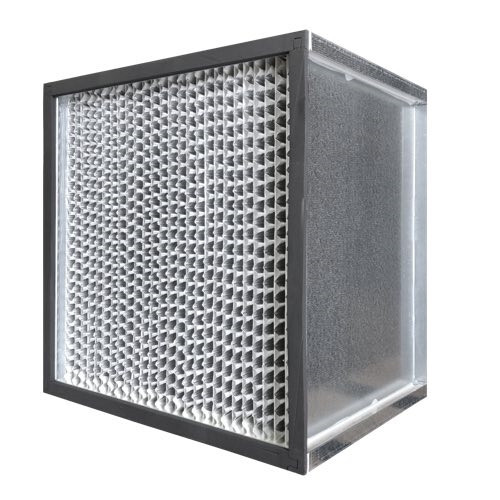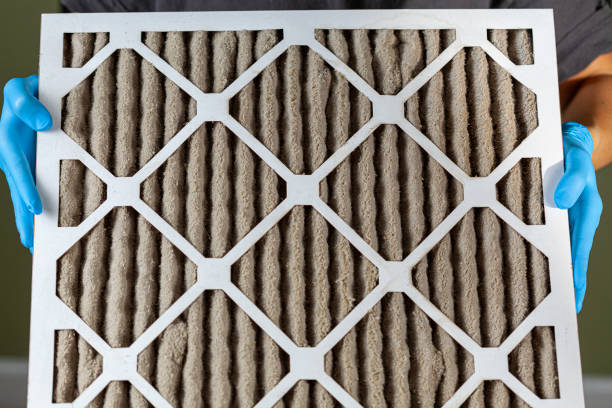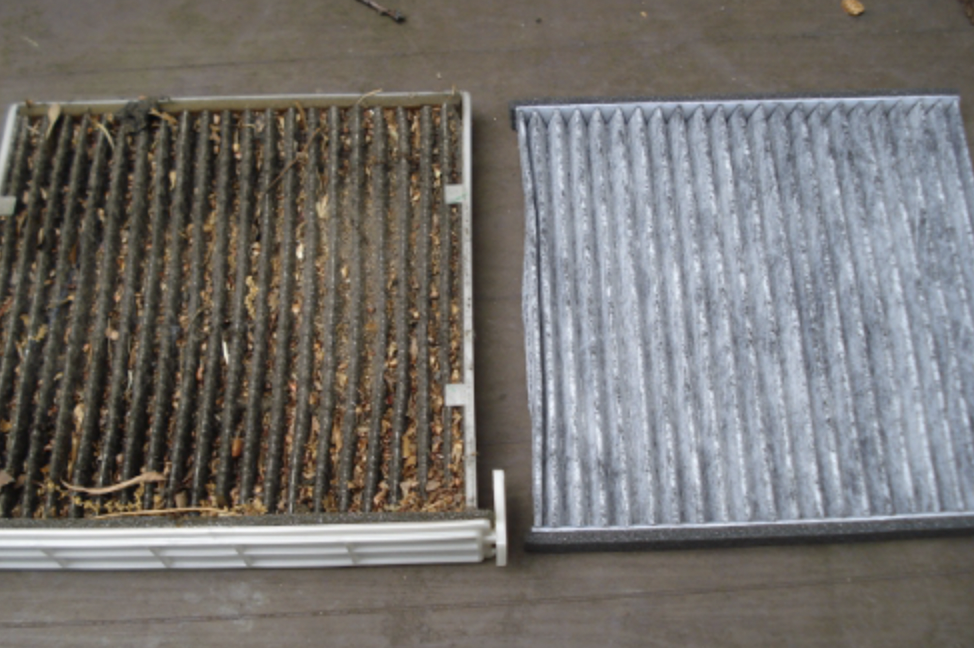Posted by Spycor Building on Mar 11th 2025
How Often Should I Replace My HEPA Filter?
Maintaining clean indoor air is crucial for your health, especially if you suffer from allergies, asthma, or live in areas impacted by pollution, wildfire smoke, or airborne contaminants. One of the most effective ways to ensure clean, breathable air is by using a HEPA (High-Efficiency Particulate Air) filter in your air purifiers, HVAC systems, and vacuum cleaners. But how often should you replace your HEPA filter to maintain optimal air quality?
In this comprehensive guide, we’ll break down how frequently you should change your HEPA filter, why it's important, and signs that indicate it's time for a replacement. Plus, if you're looking for a reliable replacement HEPA filter for your air filtration system, we've got you covered.
What Is a HEPA Filter?
A HEPA (High-Efficiency Particulate Air) filter is an advanced air filtration component designed to capture and remove at least 99.97% of airborne particles as small as 0.3 microns from the air. These particles can include a wide range of harmful contaminants such as dust, pollen, pet dander, mold spores, bacteria, and smoke particles. HEPA filters are widely regarded as one of the most effective tools for improving indoor air quality (IAQ), making them a popular choice in residential, commercial, and industrial environments.
The superior filtration ability of HEPA filters helps to significantly reduce airborne allergens, bacteria, and pollutants, ensuring cleaner and healthier air. This is especially beneficial for individuals with asthma, allergies, respiratory conditions, or sensitivities to airborne particles.
How Do HEPA Filters Work?
HEPA filters are made from a dense mat of interlaced glass fibers or synthetic materials that are arranged in a random pattern. This dense structure forces air to pass through several layers of filtration, capturing a wide range of microscopic particles. The filtration process occurs through three primary mechanisms:
-
Diffusion: This process captures ultra-fine particles (less than 0.1 microns) by causing them to collide with gas molecules, reducing their movement and trapping them in the filter. This is particularly effective in capturing smoke particles, viruses, and airborne bacteria.
-
Interception: As the air flows through the filter, particles that are larger than 0.3 microns are intercepted and captured by the fibers. This is effective for capturing dust, pollen, and pet dander.
-
Impaction: Larger particles like mold spores, dirt, and lint collide directly with the filter fibers and become trapped, preventing them from recirculating into the air.
The combination of these three mechanisms allows a HEPA filter to capture particles as small as 0.3 microns, which is about 250 times smaller than the diameter of a human hair.
What Types of Particles Can a HEPA Filter Capture?
HEPA filters are designed to capture a wide variety of harmful airborne particles that can negatively affect indoor air quality. Some of the most common particles that HEPA filters effectively capture include:
1. Dust Particles
- Size: 0.5 to 100 microns
- Source: Outdoor dirt, construction debris, HVAC dust buildup, and unclean carpets.
- Why It Matters: Dust particles can contribute to allergy flare-ups, coughing, and respiratory issues, especially for individuals with asthma or compromised immune systems.
2. Pollen
- Size: 10 to 100 microns
- Source: Trees, plants, grass, and flowers.
- Why It Matters: Pollen is a leading cause of seasonal allergies, sneezing, runny nose, and itchy eyes. HEPA filters can trap these particles, offering relief to individuals sensitive to pollen.
3. Pet Dander
- Size: 2.5 to 10 microns
- Source: Shedding hair and skin cells from pets such as cats, dogs, and rodents.
- Why It Matters: Pet dander can easily circulate through indoor air and trigger allergic reactions, asthma attacks, and respiratory issues. A HEPA filter effectively captures these microscopic particles, improving air quality for pet owners.
4. Mold Spores
- Size: 3 to 30 microns
- Source: Damp areas, water leaks, unventilated bathrooms, basements, and air conditioning systems.
- Why It Matters: Mold spores can cause respiratory issues, allergic reactions, and long-term health problems. HEPA filters trap mold spores before they have a chance to settle and multiply, reducing the spread of mold indoors.
5. Bacteria and Airborne Viruses
- Size: 0.3 to 10 microns
- Source: Humans, animals, contaminated surfaces, and outdoor air.
- Why It Matters: Certain HEPA filters, especially those designed for medical or industrial use, can capture bacteria and some viruses suspended in the air. Although a HEPA filter alone may not completely eliminate viruses, it significantly reduces airborne bacteria and virus particles, minimizing the spread of illnesses.
6. Smoke Particles
- Size: 0.3 to 1 micron
- Source: Cigarettes, wildfires, cooking, and industrial pollution.
- Why It Matters: Smoke particles are extremely small and can quickly penetrate indoor spaces, causing poor indoor air quality, respiratory irritation, and unpleasant odors. HEPA filters are highly effective in capturing smoke particles and reducing harmful pollutants from tobacco smoke, wildfire smoke, or industrial emissions.

How Often Should You Replace Your HEPA Filter?
One of the most crucial steps in maintaining clean indoor air quality is knowing when to replace your HEPA filter. Over time, your HEPA filter accumulates dust, pet dander, pollen, bacteria, mold spores, and smoke particles, reducing its efficiency in trapping airborne contaminants. Failing to replace your HEPA filter on time can lead to poor air quality, increased allergy symptoms, and higher energy consumption from your devices.
The replacement frequency of your HEPA filter largely depends on:
- The type of device you’re using (air purifier, HVAC system, vacuum cleaner, or negative air machine).
- The environment in which it operates (home with pets, commercial space, or industrial site).
- The air quality in your area (wildfire-prone, high-pollution zones, or low-occupancy spaces).
To ensure your air stays clean and breathable, here’s a detailed guideline on how often you should replace your HEPA filter based on different device types:
1. Air Purifiers with HEPA Filters
Air purifiers are among the most common household devices that rely on HEPA filters to reduce airborne pollutants such as dust, allergens, smoke, and pet dander. However, how frequently you need to replace your air purifier HEPA filter depends on how heavily the purifier is used and the air quality in your environment.
- If you live in wildfire-prone areas, near highways, or in high-pollution zones, you may need to replace your HEPA filter every 3 to 6 months.
- Regularly check the filter’s color and airflow performance. If you notice dust accumulation or reduced airflow, replace it immediately.
2. HVAC Systems with HEPA Filters
HVAC (Heating, Ventilation, and Air Conditioning) systems equipped with HEPA filters provide whole-house air filtration, ensuring clean air circulates throughout your space. However, since HVAC systems handle large air volumes, the filters tend to clog faster, especially in high-traffic environments.
- Set a reminder every 6 months to inspect your HVAC filter.
- Dirty HVAC filters can force your system to work harder, increasing energy bills and reducing the lifespan of your HVAC unit.
- If you notice dust buildup around air vents, increased allergies, or musty odors, it’s time to replace your HEPA filter.
3. Negative Air Machines with HEPA Filters
Negative air machines (also known as air scrubbers) are typically used in construction, mold remediation, hospitals, and industrial settings to create negative air pressure and remove contaminated air. Since these machines handle heavy contaminants, their HEPA filters become clogged faster than standard air purifiers or HVAC systems.
- Always refer to the manufacturer’s manual for the exact lifespan of your HEPA filter.
- For heavy industrial use, always keep spare HEPA filters on hand to avoid downtime.
4. Vacuum Cleaners with HEPA Filters
Vacuum cleaners equipped with HEPA filters are excellent for trapping fine dust, pet hair, and microscopic allergens. However, HEPA filters in vacuums can get clogged with dirt and debris, reducing suction power and overall performance.
- If your vacuum loses suction power or emits a musty odor, check the HEPA filter.
- Washable HEPA filters should still be replaced after a certain number of washes, as performance declines over time.
Why Replacing Your HEPA Filter Is Important
Replacing your HEPA (High-Efficiency Particulate Air) filter on time is crucial to maintaining clean indoor air and ensuring your devices operate at peak performance. Over time, HEPA filters become clogged with dust, pet dander, pollen, mold spores, smoke particles, and bacteria, which can significantly reduce their efficiency.
Failing to replace your HEPA filter doesn't just compromise your indoor air quality — it can also strain your appliances, increase energy costs, and pose potential health risks for you and your family. In this section, we'll break down the critical reasons why replacing your HEPA filter on time is absolutely essential.
1. Prevents Poor Indoor Air Quality
The primary function of a HEPA filter is to capture airborne contaminants such as dust, pollen, pet dander, mold spores, bacteria, and smoke particles. However, as the filter accumulates more debris, its ability to effectively trap new contaminants decreases. This leads to poor indoor air quality (IAQ), which can negatively affect your health, especially if you suffer from:
- Allergies
- Asthma
- Respiratory conditions
- Weakened immune systems
2. Protects Against Allergies, Asthma, and Respiratory Issues
If you or your family members suffer from allergies, asthma, or respiratory issues, failing to replace your HEPA filter can trigger more frequent flare-ups and health problems. A clogged filter cannot effectively capture:
- Pet dander from cats, dogs, or other animals.
- Pollen during allergy season.
- Dust and airborne bacteria from daily household activities.
3. Prevents the Growth of Mold and Bacteria
Another critical reason to replace your HEPA filter is to prevent the growth of mold, bacteria, and other harmful microorganisms. When air passes through a clogged filter filled with trapped moisture, dust, and organic particles, it creates a perfect breeding ground for mold, bacteria, and mildew.
Over time, your air purifier or HVAC system may begin to release mold spores and bacteria back into the air, significantly compromising your indoor air quality. This can lead to:
- Respiratory infections.
- Allergic reactions.
- Musty odors in your home.
4. Keeps Your Air Purifier and HVAC System Running Efficiently
A clogged HEPA filter forces your air purifier or HVAC system to work harder to push air through the filter. This not only reduces the efficiency of the device but also:
- Increases energy consumption, leading to higher electricity bills.
- Shortens the lifespan of the appliance due to overworking the motor.
- Decreases airflow, making your indoor air feel stale and heavy.
5. Eliminates Lingering Odors and Stale Air
A dirty HEPA filter can trap odors, causing your air purifier or HVAC system to circulate stale, musty air instead of fresh, clean air. This is especially noticeable if:
- You have pets.
- Someone smokes indoors.
- You recently cooked foods with strong odors.
- You experienced a wildfire or industrial pollution in your area.

Signs It's Time to Replace Your HEPA Filter
A HEPA filter plays a crucial role in keeping your home’s air clean by trapping tiny particles like dust, pet dander, pollen, and mold spores. Over time, however, these filters can become clogged and less effective, signaling that it’s time for a replacement. Here are some common signs that your HEPA filter needs to be replaced:
1. Reduced Airflow
One of the first signs that your HEPA filter needs replacing is a decrease in airflow. As the filter gets clogged with dust and particles, it restricts the movement of air through your air purifier, HVAC system, or vacuum cleaner.
- Symptoms:
- You may notice that your air purifier is running slower or less efficiently.
- Your HVAC system may struggle to circulate air properly, making rooms feel stuffy and uncomfortable.
- You may also experience a weaker suction power from your vacuum cleaner, which means it's not picking up dirt as effectively.
Why it Matters:
- Reduced airflow means your device is working harder, leading to higher energy consumption and strain on the motor, which can cause premature wear and tear on your system.
2. Strange Odors
If your air purifier or HVAC system is emitting unpleasant odors, even when the air is supposed to be clean, it could be a sign that the HEPA filter is clogged and failing to capture particles. These odors can include:
- Musty smells caused by trapped moisture, mold, or mildew.
- Pet odors that linger despite running the air purifier.
- Smoke or chemical smells that never seem to go away.
Why it Matters:
- A dirty HEPA filter can’t effectively neutralize odors. By replacing it, you eliminate these smells and ensure your air purifier or HVAC system is working as it should to keep your home smelling fresh.
3. Increased Allergy Symptoms
If you or your family members notice an increase in allergy symptoms such as sneezing, coughing, watery eyes, or congestion, it could indicate that your HEPA filter is no longer doing its job. When the filter is clogged, it fails to trap allergens like pollen, dust mites, pet dander, and other particles. As a result, these allergens are circulated back into the air, worsening allergy symptoms.
- Symptoms to watch for:
- Sneezing, coughing, or a runny nose indoors.
- Feeling congested or experiencing itchy eyes.
- Asthma flare-ups or difficulty breathing in areas where the air purifier or HVAC system runs.
Why it Matters:
- Replacing your HEPA filter regularly helps remove allergens from the air, providing relief for allergy and asthma sufferers and improving overall indoor air quality.
4. Visible Dirt or Dust Buildup
One of the easiest ways to check if your HEPA filter needs replacement is by inspecting it directly. If you notice that the filter is visibly covered in dust, dirt, or debris, it’s time for a change. Over time, filters will accumulate contaminants, and if they’re too dirty, they can no longer capture new particles effectively.
- Check the filter:
- Hold it up to the light; if you can’t see through it clearly or it’s covered in dust, it’s time to replace it.
- If the filter is saturated with particles, the air purifier or HVAC system will struggle to pull air through it, leading to inefficiency.
Why it Matters:
- A dirty HEPA filter compromises your system’s ability to keep the air clean. By replacing it, you ensure maximum filtration efficiency and ensure cleaner air in your home.
When it comes to maintaining the effectiveness of your air purifier, HVAC system, or vacuum cleaner, replacing the HEPA filter at the right time is crucial. However, finding the right replacement filter that fits your specific device can often be challenging, as there are many different models and sizes available. It's important to ensure you're purchasing a filter that is compatible with your system and provides the filtration efficiency you're seeking.
Click Here to check the best HEPA filter for your needs and enjoy cleaner, fresher air today!



